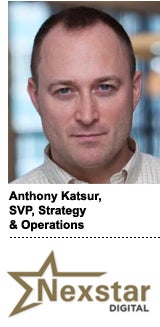In the immortal words of former House speaker Tip O’Neill: “All politics is local.”
And the same can be said for reopening the US economy as states and counties across the country attempt to ease their COVID-19 restrictions.
As the largest local broadcast television group in the United States, Nexstar Media Group heavily relies on local advertising, much of which dried up or went on hiatus during lockdown.
But the local nature of Nexstar’s business and its digital media solutions arm, Nexstar Digital, is also an asset. America’s phased reopening requires agility in messaging and targeting, said Anthony Katsur, SVP of digital strategy and corporate development at Nexstar Digital.
Nexstar has nearly 200 local stations that reach 63% of US households, and it attracts roughly 110 million monthly digital uniques to its owned-and-operated properties.
“We were impacted just like the entire industry by the shutdowns, which were very local in nature,” said Katsur, an ad tech vet whose resumé includes executive stints at iSocket, Rubicon Project and Sonobi.
“But we also give advertisers flexibility,” he said. “We may even see certain markets or regions go back into shutdown mode, and advertisers will have to manage their buys accordingly – and efficiently.”
Katsur spoke with AdExchanger.
AdExchanger: How has the pandemic affected your business?
ANTHONY KATSUR: COVID-19 has been an interesting conundrum. On the one hand, there’s probably never been a bigger local news story in human history, and we’ve seen viewership increase by low double-digit percentages in linear. Our digital audiences have more than doubled.
At the same time, we have local and regional advertisers that have had to shut down during the crisis. If your DMA is shut down and your business isn’t open, it doesn’t make sense to advertise.
But as markets begin to open as per local governments, we can craft curated media offerings to advertise only in those markets. Local reach has also been very appealing to regional and national advertisers. National buys don’t make sense if some markets are closed, but it does make sense to extend reach into markets where their brick-and-mortar stores are open.
Can you share some examples?
Many QSR brands are regional and/or national, and a lot of them remained open for drive-thru and online ordering. We’ve been working with QSRs, particularly on the digital side, to drive people to order more online.
It’s been the same with grocery stores, which are typically very regional businesses that need regionalized messaging. New York state, for example, is going through different phases of reopening, and there are grocery chains with stores in multiple regions of the state. They need to modify their messages based on the phase and not advertise in those markets where it’s not yet appropriate.
Are you working with more national advertisers now?
We’ve been very engaged with national retailers on how to curate their buys. And it’s complicated. Some markets have opened, some are in the process of opening and some never even really closed. National advertisers curate their buys through our O&O and can extend them to our third-party media partners using our audience data or their own data.
We have our own tech stack for monetization on our O&O and for audience extension. I can’t think of a market we can’t get into. We can extend digitally into regional ad markets even if we don’t own any stations there.
How are small businesses doing?
It’s been amazing to see how quickly small businesses have returned to advertising, both digital and linear, as communities have reopened. These are businesses with sometimes just five or 10 employees.
We’ve seen this trend play out across the country. Inbound demand to get their advertising back online is directly correlated to mayor and governor mandates about reopening certain regions. When the reopening started in upstate New York, for example, our stations there saw a huge and immediate surge in advertising demand.
What other advertiser trends have you been noticing during the pandemic?
We’re seeing that KPIs have become more stringent, because it’s a lot easier to measure ecommerce than brick-and-mortar ROI.
How much of a boon is political advertising?
More money is going toward advertising in this phase of the election cycle than we’ve seen historically, and we haven’t even hit critical mass yet. By mid-July through October, ad budgets are really going to take off.
It’s being magnified by COVID-19. Until Tulsa, there were no rallies, and the budget that was earmarked for live events has been going toward advertising, because it’s the only way candidates can get their message out in local and national markets right now. They’re repurposing those ad dollars, a lot of which are going to OTT, pre-roll and even mobile app video.
And even compared to just two years ago, we’re seeing political advertising become increasingly data-driven. We have integrations with voter registration files and partnerships with several political data companies. There’s also a higher level of accountability in terms of performance. Advertisers are looking for people to visit issue sites, a candidate’s site and to register for grassroots support. The KPIs in political advertising are becoming much more quantifiable.
This interview has been edited and condensed.













